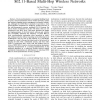INFOCOM
2008
IEEE
14 years 6 months ago
2008
IEEE
Abstract—Radio channel quality of real-world wireless networks tends to exhibit both short-term and long-term temporal variations that are in general difficult to model. To maxi...
ICDCS
2008
IEEE
14 years 6 months ago
2008
IEEE
—Recently, there has been a growing interest of using network coding to improve the performance of wireless networks, for example, authors of [1] proposed the practical wireless ...
FGCN
2008
IEEE
14 years 6 months ago
2008
IEEE
The technology of Worldwide Interoperability for Microwave Access (WiMAX) is based on the IEEE 802.16 standard which enables the delivery of last mile wireless broadband access wi...
CISS
2008
IEEE
14 years 6 months ago
2008
IEEE
Abstract—Relay cooperation has been recognized as an important mechanism to enhance connectivity and throughput in multi-hop wireless networks, especially under varying channel c...
AINA
2008
IEEE
14 years 6 months ago
2008
IEEE
In this paper we present the design and usage of the multi-purpose wireless network emulator that we develop, QOMET. QOMET implements a two-stage scenario-driven approach to wirel...
INFOCOM
2009
IEEE
14 years 6 months ago
2009
IEEE
—Routing to mobile nodes in a wireless network is conventionally performed by associating a static IP address (or a geographic location) to each node, and routing to that address...
ICNP
2009
IEEE
14 years 6 months ago
2009
IEEE
—Clock synchronization is an essential building block for many control mechanisms used in wireless networks, including frequency hopping, power management, and packet scheduling....
ICC
2009
IEEE
14 years 6 months ago
2009
IEEE
—A variety of wireless network technologies have been developed and deployed, including GSM, UMTS, WiFi and WiMAX. The advantages of having an integrated heterogeneous wireless n...
ICC
2009
IEEE
14 years 6 months ago
2009
IEEE
—How to efficiently use the air interface is a crucial issue in wireless networks. In order to improve the performance, mechanisms have been proposed to improve the reach and th...
GLOBECOM
2009
IEEE
14 years 6 months ago
2009
IEEE
—With increasing spatial reuse of the radio spectrum, co-channel interference is becoming the dominant noise source and may severely degrade the communication performance of wire...





